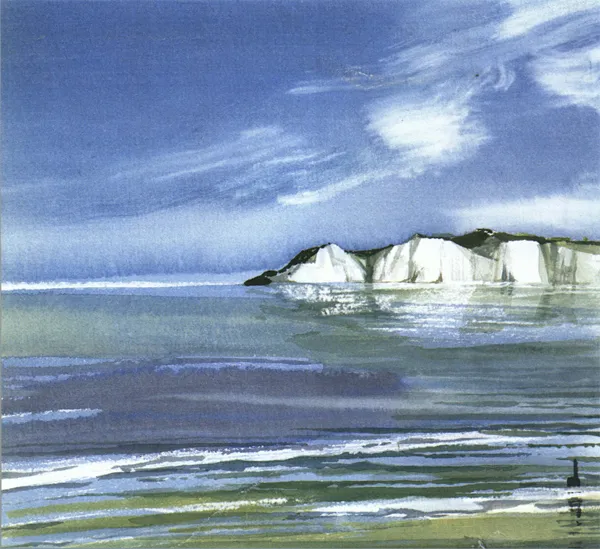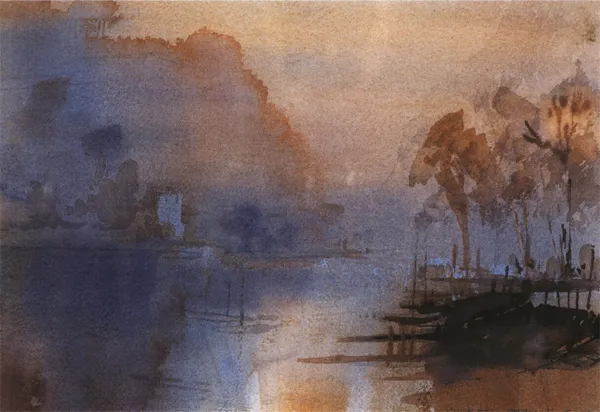
eBook - ePub
Painting Expressive Watercolours
Mike Chaplin, Diana Vowles
This is a test
Partager le livre
- English
- ePUB (adapté aux mobiles)
- Disponible sur iOS et Android
eBook - ePub
Painting Expressive Watercolours
Mike Chaplin, Diana Vowles
Détails du livre
Aperçu du livre
Table des matières
Citations
À propos de ce livre
Mike Chaplin is one of the most popular art experts on the very successful Channel 4 series Watercolour Challenge. In this book he reveals how he works and puts forward his ideas and teaching methods, offering plenty of tips and practical advice for the amateur artist.
Foire aux questions
Comment puis-je résilier mon abonnement ?
Il vous suffit de vous rendre dans la section compte dans paramètres et de cliquer sur « Résilier l’abonnement ». C’est aussi simple que cela ! Une fois que vous aurez résilié votre abonnement, il restera actif pour le reste de la période pour laquelle vous avez payé. Découvrez-en plus ici.
Puis-je / comment puis-je télécharger des livres ?
Pour le moment, tous nos livres en format ePub adaptés aux mobiles peuvent être téléchargés via l’application. La plupart de nos PDF sont également disponibles en téléchargement et les autres seront téléchargeables très prochainement. Découvrez-en plus ici.
Quelle est la différence entre les formules tarifaires ?
Les deux abonnements vous donnent un accès complet à la bibliothèque et à toutes les fonctionnalités de Perlego. Les seules différences sont les tarifs ainsi que la période d’abonnement : avec l’abonnement annuel, vous économiserez environ 30 % par rapport à 12 mois d’abonnement mensuel.
Qu’est-ce que Perlego ?
Nous sommes un service d’abonnement à des ouvrages universitaires en ligne, où vous pouvez accéder à toute une bibliothèque pour un prix inférieur à celui d’un seul livre par mois. Avec plus d’un million de livres sur plus de 1 000 sujets, nous avons ce qu’il vous faut ! Découvrez-en plus ici.
Prenez-vous en charge la synthèse vocale ?
Recherchez le symbole Écouter sur votre prochain livre pour voir si vous pouvez l’écouter. L’outil Écouter lit le texte à haute voix pour vous, en surlignant le passage qui est en cours de lecture. Vous pouvez le mettre sur pause, l’accélérer ou le ralentir. Découvrez-en plus ici.
Est-ce que Painting Expressive Watercolours est un PDF/ePUB en ligne ?
Oui, vous pouvez accéder à Painting Expressive Watercolours par Mike Chaplin, Diana Vowles en format PDF et/ou ePUB ainsi qu’à d’autres livres populaires dans Art et Art Techniques. Nous disposons de plus d’un million d’ouvrages à découvrir dans notre catalogue.
Informations
Sujet
ArtSous-sujet
Art TechniquesThe Natural Landscape
Traditionally, British watercolour painters have always had a strong affinity with the landscape and they have also been great travellers at home and abroad. Working en plein air makes us aware of the subtlety of nature and what we can learn from it about line, tone, colour, pattern and in particular a sense of the place.

FOOTPATH AT DELPHI
51 × 71cm (20 × 28in)
This study of a hillside path at Delphi in Greece captures some of the quiet poetry of this magical site. The yellow colour range was not in fact present in the landscape but conveys a sense of heat that describes the emotion of the scene.
Skies
The range of tones in a clear sky from the horizon to immediately overhead is remarkable. This is because when we look upwards our view through the earth’s atmosphere is shorter than when we are looking straight ahead towards the distant sky, so the blue wavelength is less distorted by impurities. Gradating to lighter tones of blue towards the horizon is essential to establish a sense of distance, and if you fail to observe this any work you put into achieving a recessive effect in the land below will be wasted.
The angle of the sun has a huge effect on skies, particularly if there is reflected light from large expanses of water which is bounced back up to the clouds. Try working at different times of day in varying weather conditions and alter your own position in relation to the light.

SEA AND SKY WITH CLIFFS
25.5 × 30.5cm (10 × 12in)
With the sun high and coming directly from behind me, the colours in this painting are pure and fresh. The cirrus clouds, lifted out of the wash with a tissue, are flat white.
Breaking the rules
We are always told not to put the horizon halfway up the composition because it will divide it in two. Here I have shown two studies that break this rule and make a strong point. The sky has such an effect on the landscape, particularly in the case of reflections, that the two elements often both fall within the same paint range. In these two paintings the composition becomes complete because of the echoes of colour and tone between the land and the sky. The horizon is bridged and the painting is balanced.
Wherever you choose to place your horizon, do not think of the sky and the land as two separate entities. If you paint the sky as one operation and the land as another it will be obvious that the painting is split in two. You need to take a unified approach and this does not apply just to colours and tones but also to the type of marks, be they calm or vigorous, so that the temperament of the painting is coherent.
Remember that the sky is always changing and is a constant source of fresh subject matter, even if you have to paint through the window because of bad weather.

SEASHORE AND SKY
20.5 × 25.5cm (8 × 10in)
Here I was looking into the evening light. The sun is low and silhouettes the clouds, giving strong tones and subtle colours. The tones also describe the volume of the clouds.
Weather effects
Watercolour is a particularly good medium for capturing fleeting moments of weather. Its very elusiveness as a way of working will sometimes catch exactly that transparency of space that weather brings.
You often cannot see weather, only the results of it. I do not recommend that you strap yourself to the mast to capture a storm at sea as Turner did, but, more realistically, that you write notes to use as an aide-mémoire when you are back in the studio. It is quite difficult to resolve a vague intellectual idea about a particular weather effect into the practicalities of painting, but if you write it into a sentence you actually have to formalize that idea into something quite specific. ‘The wind whipped the leaves from the trees’ or ‘the sky turned dark with snow, speckled dark and white in a whirling texture’ gives you the factual information you need in the studio when the painting is underway. You can also conjure up the emotion involved: ‘wind whipped’ is alliterative, sharp and spiky and inspires brushwork with hard spiky edges and some sharp diagonals. I find there are such analogies between the structure of writing and painting that working in another medium for a few minutes can give me the clue as to how to express the idea in paint.

ITALIAN LAKES, EARLY MORNING
25.5 × 30.5cm (10 × 12in)
During a journey home from Venice on a very early morning I made an unscheduled stop to capture these swathes of mist rising from a lake, shortly to he burnt off by the rising sun – a magic moment.
Subtle treatments
Mist, rain and snow act as a transparent or semitransparent veil of weather interposed between artist and subject. Mist is one of the most difficult weather effects to catch but it can be done by laying veils of horizontal transparent wash over the underlying painting to obscure the subject beyond slightly. These need to be laid very fast or they will disturb the painting underneath. This is a time when acrylic paints are useful. Used very wet they look exactly like watercolour but once they are dry they will not be disturbed by further washes, so you can lay a series of glazes of very pure, subtle colour.
On a gloomy day, do not be put off by the threat of rain – it can introduce highlights where previously none existed. Light reflecting from shiny surfaces can give a sparkle to paintings, and stones or slates that look monotone and flat when dry will become a pattern of light, medium and dark tones once they are wet. There is no need to show rain falling; dark clouds and reflections will tell the viewer the story, and you can also include figures with umbrellas or oilskins.
Snowy ground becomes a giant reflector and shines light upwards on to nearby objects and buildings. Normally the sky is lighter than the ground but now it will be a darker tone, especially if more snow is on the way.

CLOCK TOWER AT MOTE PARK
25.5 × 35.5cm (10 × 14in)
The crispness of a cold winter’s day is best reflected in colour put down fast and cleanly. The watery light of the winter months often reveals pure, clear colour as in the copper dome of the clock tower.
Water
When it comes to degrees of difficulty in painting, for most people the elusiveness of water ranks pretty high. In fact, there is no elaborate trick to painting water; you just have to study what is happening to the water in a small area. The larger picture is just lots of those little areas put together and it is merely a question of endurance getting it all down!
Many people find disturbed water harder to paint than a flat surface, but understanding the nature of the reflections provides the clue as to how to tackle it. Each wave is like two mirrors, one coming towards you and reflecting what is behind you and the other surface lying away from you to reflect what is in front of you. So, for example, if you have a big tree ahead of you and the sky behind, h...